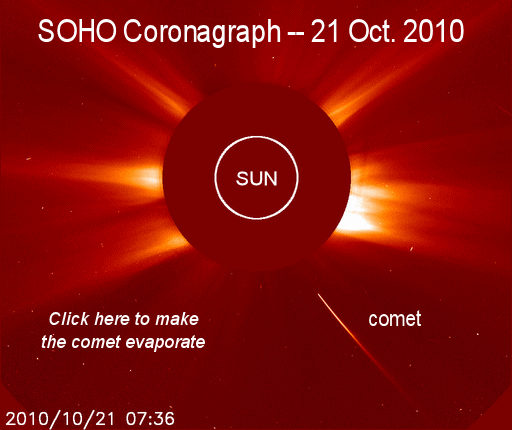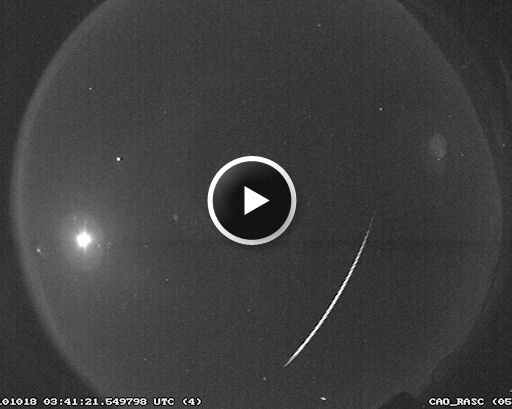COMET HARTLEY 2 UPDATE: Comet Hartley 2 is now about 11 million miles from Earth, one of the closest approaches of any comet in the last few centuries. Unfortunately, the Moon is waxing full at the same time. Glaring moonlight will make the comet difficult to observe for the next week at least. Indeed, the next great shot you see might come from EPOXI.
SUNDIVING COMET: The solar system now has one less comet. Earlier today, a sundiving comet discovered on Oct. 19th by Chinese amateur astronomer Bo Zhou passed too close to the sun and apparently evaporated. A coronagraph onboard the Solar and Heliospheric Observatory (SOHO) recorded the death plunge:

The comet was likely a member of the Kreutz sungrazer family. Named after a 19th century German astronomer who studied them in detail, Kreutz sungrazers are fragments from the breakup of a giant comet at least 2000 years ago. Several of these fragments are thought to pass by the sun and disintegrate every day. Most are too small to see but occasionally a big fragment like this one attracts attention.
ORIONID METEOR SHOWER: Earth is passing through a broad stream of debris from Halley's Comet, and this is causing the annual Orionid meteor shower. "The best time to look is during the hours before dawn on Thursday, Oct. 21st, and again on Friday, Oct 22nd," advises Bill Cooke of NASA's Meteoroid Environment Office. "Unfortunately, we have a bright Moon this year. Even so, I'd expect some bright Orionids to shine through the moonlight." An all-sky camera at the University of Western Ontario recorded this early Orionid fireball on Oct. 18th:

Orionid meteors stream from the elbow of Orion the Hunter: sky map. Because the shower's radiant point is close to the celestial equator, sky watchers in both hemispheres can enjoy the show. Moonlit meteor rates will probably be around a dozen per hour.
Radar rates could be much higher. The US Air Force Space Surveillance Radar in Texas is scanning the skies for satellites, space junk, and meteoroids. When an Orionid passes overhead--ping!--there is an echo. Moonlight does not interfere with this method of meteor observing, so it's perfect for this year's Orionids. Tune into Spaceweather Radio for live echoes.
Orionid images: from John Chumack of Dayton, Ohio; from Calvin Hall of Knik Valley, near Palmer Alaska; from Martin Popek of Nýdek, Czech republic
October 2010 Aurora Gallery
[previous Octobers: 2009, 2008, 2007, 2006, 2004, 2003, 2002, 2001]
Potentially Hazardous Asteroids (
PHAs) are space rocks larger than approximately 100m that can come closer to Earth than 0.05 AU. None of the known PHAs is on a collision course with our planet, although astronomers are finding
new ones all the time.
On October 21, 2010 there were 1155 potentially hazardous asteroids.
Notes: LD means "Lunar Distance." 1 LD = 384,401 km, the distance between Earth and the Moon. 1 LD also equals 0.00256 AU. MAG is the visual magnitude of the asteroid on the date of closest approach. | | The official U.S. government space weather bureau |
| | The first place to look for information about sundogs, pillars, rainbows and related phenomena. |
| | Researchers call it a "Hubble for the sun." SDO is the most advanced solar observatory ever. |
| | 3D views of the sun from NASA's Solar and Terrestrial Relations Observatory |
| | Realtime and archival images of the Sun from SOHO. |
| | from the NOAA Space Environment Center |
| | the underlying science of space weather |

